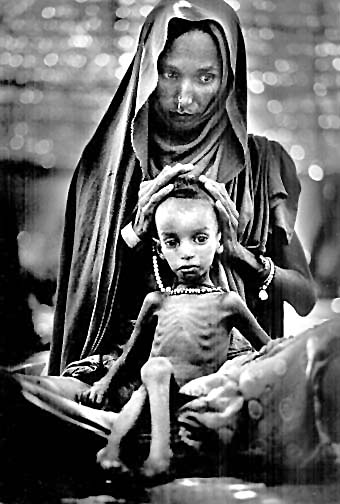Caution: Disturbing images
__________________________________
Between 1942 and 1967 a Pulitzer Prize for Photography was awarded for photojournalism, that is, for photographs telling a news story. In 1968 that award was replaced by awards in two new categories:
- the Pulitzer Prize for Spot News Photography (photography in the nature of breaking news, as it has been called since 2000); and
- the Pulitzer Prize for Feature Photography (human interest and matters associated with new items).
From 1955 World Press Photo has awarded prizes for the best photographs in 10 categories, with an overall award for the image that "... is not only the photojournalistic encapsulation of the year, but represents an issue, situation or event of great journalistic importance, and does so in a way that demonstrates an outstanding level of visual perception and creativity".
This series looks at the winners, from inception.
__________________________________
Year:
1984
Award:
Pulitzer Prize for Spot (Breaking) News
Photographer:
Stan Grossfeld, Boston Globe
Subject:
A series of photographs which reveal the effects of war on the people of Lebanon.
Ethiopian mother and child in Wad Sharafin Camp in the Sudan, 1984. The image has been referred to as the Third World Madonna and Child.
Background:
Between 1975 and 1990 Lebanon was subject to a civil war that took an estimated 120,000 lives. At 2012 approximately 76,000 people remained displaced within Lebanon with almost one million people having left Lebanon as a result of the war.
Before the war, Lebanon was multisectarian:
- Sunni Muslims and Christians the majorities on the coastal cities;
- Shia Muslims mainly based in the south and the Beqaa to the east;
- the mountain populations being in their majority Druze and Christian.
Although the government of Lebanon had been run by mainly Maronite Christian elites, the establishment of the state of Israel and the displacement of a hundred thousand Palestinian refugees to Lebanon during the 1948 and 1967 exoduses contributed to shifting the demographic balance in favor of the Muslim population. The Cold War caused further breakdown of the arrangements: Maronites sided with the West while leftist and pan-Arab groups sided with Soviet-aligned Arab countries.
Fighting between Maronite and Palestinian forces (mainly from the Palestine Liberation Organization) began in 1975. Shifting alliances left the situation fluid , with foreign powers such as Israel and Syria also becoming involved in the war. Peace keeping forces, such as the Multinational Force in Lebanon & UNIFIL, were also stationed in Lebanon. The fighting was brought to an end with the assistance of the Arab League with pardons of political crimes, dissolution of militias (with the exception of Hezbollah) and rebuilding, but religious tensions between Sunnis and Shias remain.
The Photographer:
Stan Grossfeld (1951- ) is a photographer, writer and editor at The Boston Globe who has won two Pulitzer Prizes for photojournalism:
- in 1984 for Spot News Photography for a "series of unusual photographs which reveal the effects of war on the people of Lebanon"; and
- in 1985 for Feature Photography Pulitzer for a "series of photographs of the famine in Ethiopia and for his pictures of illegal aliens on the Mexican border."
Stan Grossfeld
Gallery:
Frightened children herded on board a truck
Comments:
“In some ways, it’s a lot easier with the digital revolution. Everyone has Wi-Fi and you can get your pictures up anywhere. You never knew what was on your film, but you can see it all with digital. There used to be so much more mystery to it. With digital, it’s all right there. I remember having to bribe flight attendants to bring my film back to Boston from all over the world. Then you just had to hope you had something on your film when it got there. It’s still storytelling but you can mould it more cohesively. It’s important to tell a story in an entertaining and truthful way. Show something different that [the consumer] didn’t know about and maybe try to make a difference in whatever we’re trying to show. I don’t look at myself as someone who makes an impact. My photos are seen by hundreds of thousands of people and they resonate in different ways with different people.”
- Stan Grossfeld
_____________________________
Year:
1984
Award:
Pulitzer Prize for Feature Photography
Photographer:
Anthony Suau, The Denver Post
Subject:
“A series of photographs which depict the tragic effects of starvation in Ethiopia and for a single photograph of a woman at her husband's gravesite on Memorial Day."
About the photograph:
Anthony Suau was at the Fort Logan National Cemetery in Denver, Colorado to take an appropriate Memorial Day photograph for the cover of the Denver Post when he saw a woman hugging the tombstone of her late husband. She released her hold and Suau fitted a longer lens in anticipation of the image being repeated. This she did and he took the photograph. He then waited for her to leave and sought her permission to publish the photograph. The woman, Mrs. Dorris Fielder, was the widow of Mr. Cecil Fielder, an Air Force veteran of World War II, the Korean Conflict and the Vietnam War.
__________________________________
Year:
1984
Award:
World Press Photograph of the Year
Photographer:
Mustafa Bozdemir
Subject:
Earthquake in Turkey
The image is too sad to post. Anyone who wants to see the photograph can click on the following link:
Comments:
In Koyunoren, Turkey, Kezban Özer finds her five children who were buried alive after a magnitude-7.1 earthquake struck her village. The earthquake occurred at 5 a.m., when she and her husband were milking the cows and their children were sleeping. The earthquake destroyed 147 villages in the region and killed 1,336 people.








No comments:
Post a Comment
Note: Only a member of this blog may post a comment.